Project Control and Management Analysis Report - Finance, 2020
VerifiedAdded on 2022/08/18
|13
|3746
|12
Report
AI Summary
This report provides an in-depth analysis of project control and management, beginning with an identification of project stages and lifecycles, including the stages of a project and its lifecycle from initiation to commissioning, as well as an evaluation of projects within the management of operational activities. The report then explores various project methodologies, including Agile and Scrum, and their purposes, along with the procedure for developing an efficient project organization environment and recognizing communication with all project stakeholders. The second part of the report focuses on developing a project plan, identifying, and mitigating risks, including the establishment of a project plan to attain a specified aim and the financial mechanisms involved in the effective control of project design. Finally, the report discusses the construction of a monitoring and review strategy for the project, with references to relevant literature.
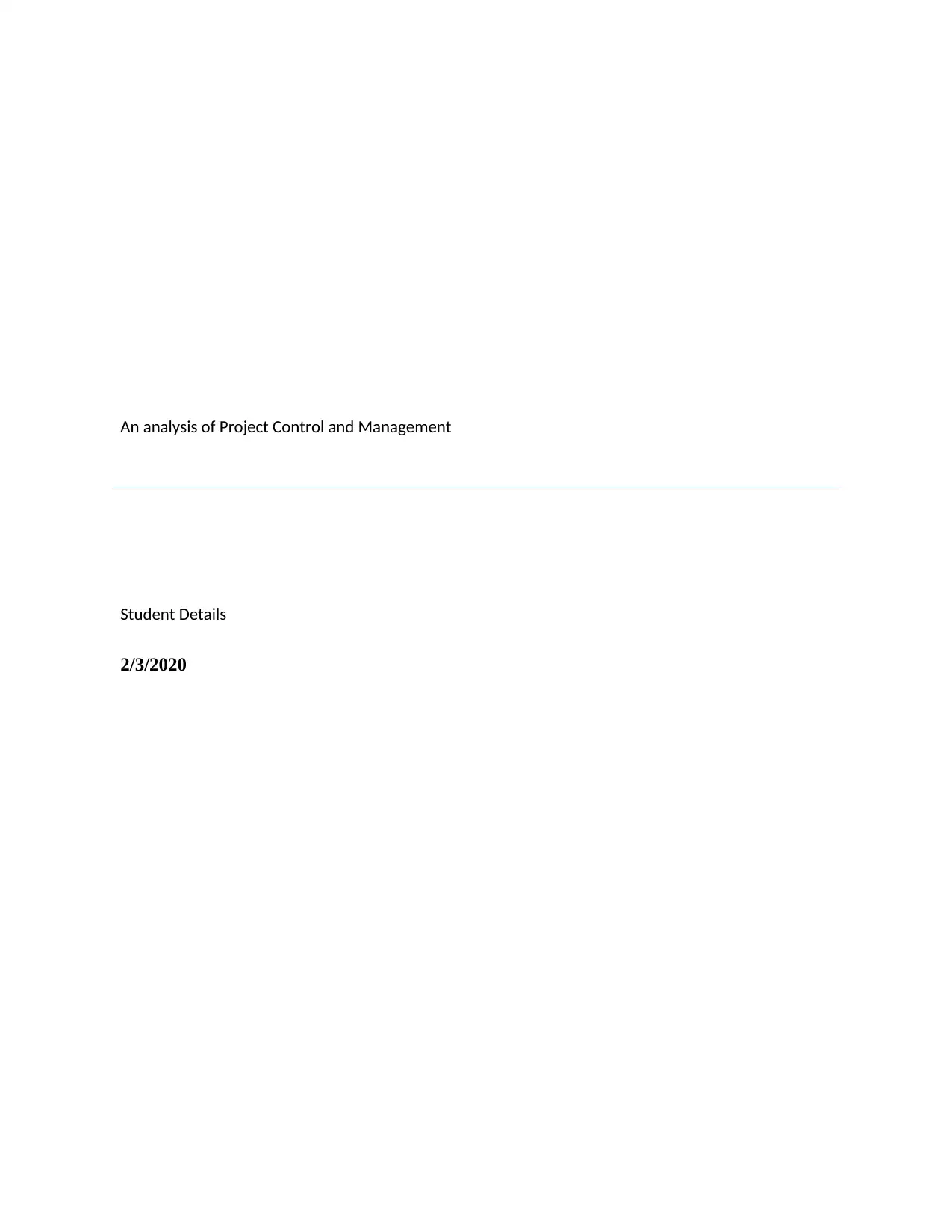
An analysis of Project Control and Management
Student Details
2/3/2020
Student Details
2/3/2020
Paraphrase This Document
Need a fresh take? Get an instant paraphrase of this document with our AI Paraphraser

Contents
Task 1...............................................................................................................................................3
1. Identification of the Components of Project Stages as well as Lifecycle.............................3
1.1. Constituent Stages of a Project:........................................................................................3
1.2. The lifecycle of the project from beginning to commissioning stage:..............................3
1.3. Evaluation of projects fit in the management of operational activities:...........................4
2. Understanding Project Methodologies as well as their Purpose...........................................4
2.1. Standard approaches available to manage projects:..........................................................4
2.2. The procedure for developing an efficient project organization environment:................5
2.3. Recognition of Communication with all Project Stakeholders:........................................5
2.4. Fundamentals of an Industry Case to Stand the Project:..................................................6
Task 2...............................................................................................................................................7
3. Development of the project plan, identification and mitigation of risks..............................7
3.1. Establishment of Project Plan to Attain a Specified Aim.................................................7
3.2. Financial Mechanism including Risk Assessment in effective Control of Project Design:
10
4. Construction of the monitoring and review strategy..............................................................11
4.1. Construction of the Monitoring as well as Reviewing Approach for the Project:..........11
Bibliography..................................................................................................................................12
Task 1...............................................................................................................................................3
1. Identification of the Components of Project Stages as well as Lifecycle.............................3
1.1. Constituent Stages of a Project:........................................................................................3
1.2. The lifecycle of the project from beginning to commissioning stage:..............................3
1.3. Evaluation of projects fit in the management of operational activities:...........................4
2. Understanding Project Methodologies as well as their Purpose...........................................4
2.1. Standard approaches available to manage projects:..........................................................4
2.2. The procedure for developing an efficient project organization environment:................5
2.3. Recognition of Communication with all Project Stakeholders:........................................5
2.4. Fundamentals of an Industry Case to Stand the Project:..................................................6
Task 2...............................................................................................................................................7
3. Development of the project plan, identification and mitigation of risks..............................7
3.1. Establishment of Project Plan to Attain a Specified Aim.................................................7
3.2. Financial Mechanism including Risk Assessment in effective Control of Project Design:
10
4. Construction of the monitoring and review strategy..............................................................11
4.1. Construction of the Monitoring as well as Reviewing Approach for the Project:..........11
Bibliography..................................................................................................................................12
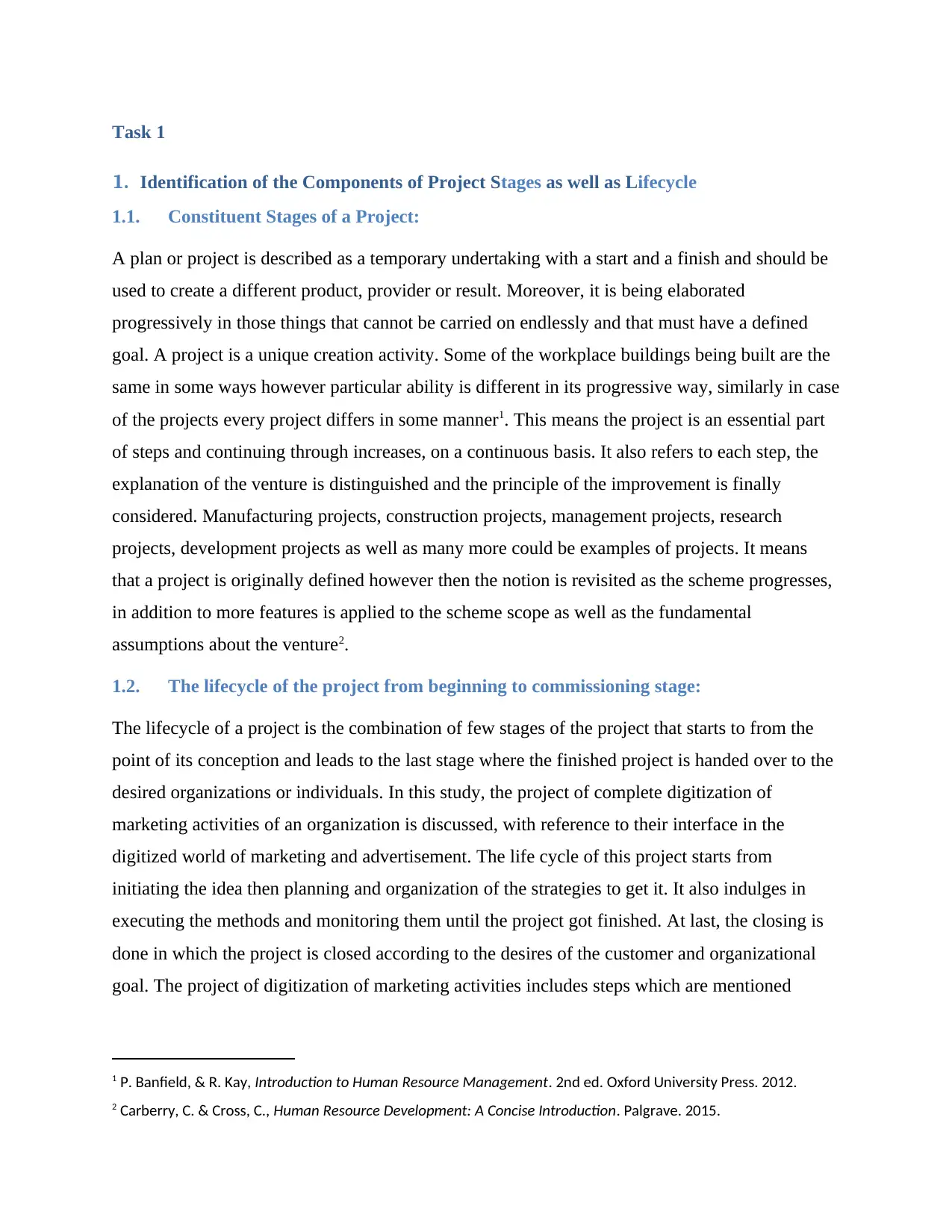
Task 1
1. Identification of the Components of Project Stages as well as Lifecycle
1.1. Constituent Stages of a Project:
A plan or project is described as a temporary undertaking with a start and a finish and should be
used to create a different product, provider or result. Moreover, it is being elaborated
progressively in those things that cannot be carried on endlessly and that must have a defined
goal. A project is a unique creation activity. Some of the workplace buildings being built are the
same in some ways however particular ability is different in its progressive way, similarly in case
of the projects every project differs in some manner1. This means the project is an essential part
of steps and continuing through increases, on a continuous basis. It also refers to each step, the
explanation of the venture is distinguished and the principle of the improvement is finally
considered. Manufacturing projects, construction projects, management projects, research
projects, development projects as well as many more could be examples of projects. It means
that a project is originally defined however then the notion is revisited as the scheme progresses,
in addition to more features is applied to the scheme scope as well as the fundamental
assumptions about the venture2.
1.2. The lifecycle of the project from beginning to commissioning stage:
The lifecycle of a project is the combination of few stages of the project that starts to from the
point of its conception and leads to the last stage where the finished project is handed over to the
desired organizations or individuals. In this study, the project of complete digitization of
marketing activities of an organization is discussed, with reference to their interface in the
digitized world of marketing and advertisement. The life cycle of this project starts from
initiating the idea then planning and organization of the strategies to get it. It also indulges in
executing the methods and monitoring them until the project got finished. At last, the closing is
done in which the project is closed according to the desires of the customer and organizational
goal. The project of digitization of marketing activities includes steps which are mentioned
1 P. Banfield, & R. Kay, Introduction to Human Resource Management. 2nd ed. Oxford University Press. 2012.
2 Carberry, C. & Cross, C., Human Resource Development: A Concise Introduction. Palgrave. 2015.
1. Identification of the Components of Project Stages as well as Lifecycle
1.1. Constituent Stages of a Project:
A plan or project is described as a temporary undertaking with a start and a finish and should be
used to create a different product, provider or result. Moreover, it is being elaborated
progressively in those things that cannot be carried on endlessly and that must have a defined
goal. A project is a unique creation activity. Some of the workplace buildings being built are the
same in some ways however particular ability is different in its progressive way, similarly in case
of the projects every project differs in some manner1. This means the project is an essential part
of steps and continuing through increases, on a continuous basis. It also refers to each step, the
explanation of the venture is distinguished and the principle of the improvement is finally
considered. Manufacturing projects, construction projects, management projects, research
projects, development projects as well as many more could be examples of projects. It means
that a project is originally defined however then the notion is revisited as the scheme progresses,
in addition to more features is applied to the scheme scope as well as the fundamental
assumptions about the venture2.
1.2. The lifecycle of the project from beginning to commissioning stage:
The lifecycle of a project is the combination of few stages of the project that starts to from the
point of its conception and leads to the last stage where the finished project is handed over to the
desired organizations or individuals. In this study, the project of complete digitization of
marketing activities of an organization is discussed, with reference to their interface in the
digitized world of marketing and advertisement. The life cycle of this project starts from
initiating the idea then planning and organization of the strategies to get it. It also indulges in
executing the methods and monitoring them until the project got finished. At last, the closing is
done in which the project is closed according to the desires of the customer and organizational
goal. The project of digitization of marketing activities includes steps which are mentioned
1 P. Banfield, & R. Kay, Introduction to Human Resource Management. 2nd ed. Oxford University Press. 2012.
2 Carberry, C. & Cross, C., Human Resource Development: A Concise Introduction. Palgrave. 2015.
⊘ This is a preview!⊘
Do you want full access?
Subscribe today to unlock all pages.

Trusted by 1+ million students worldwide
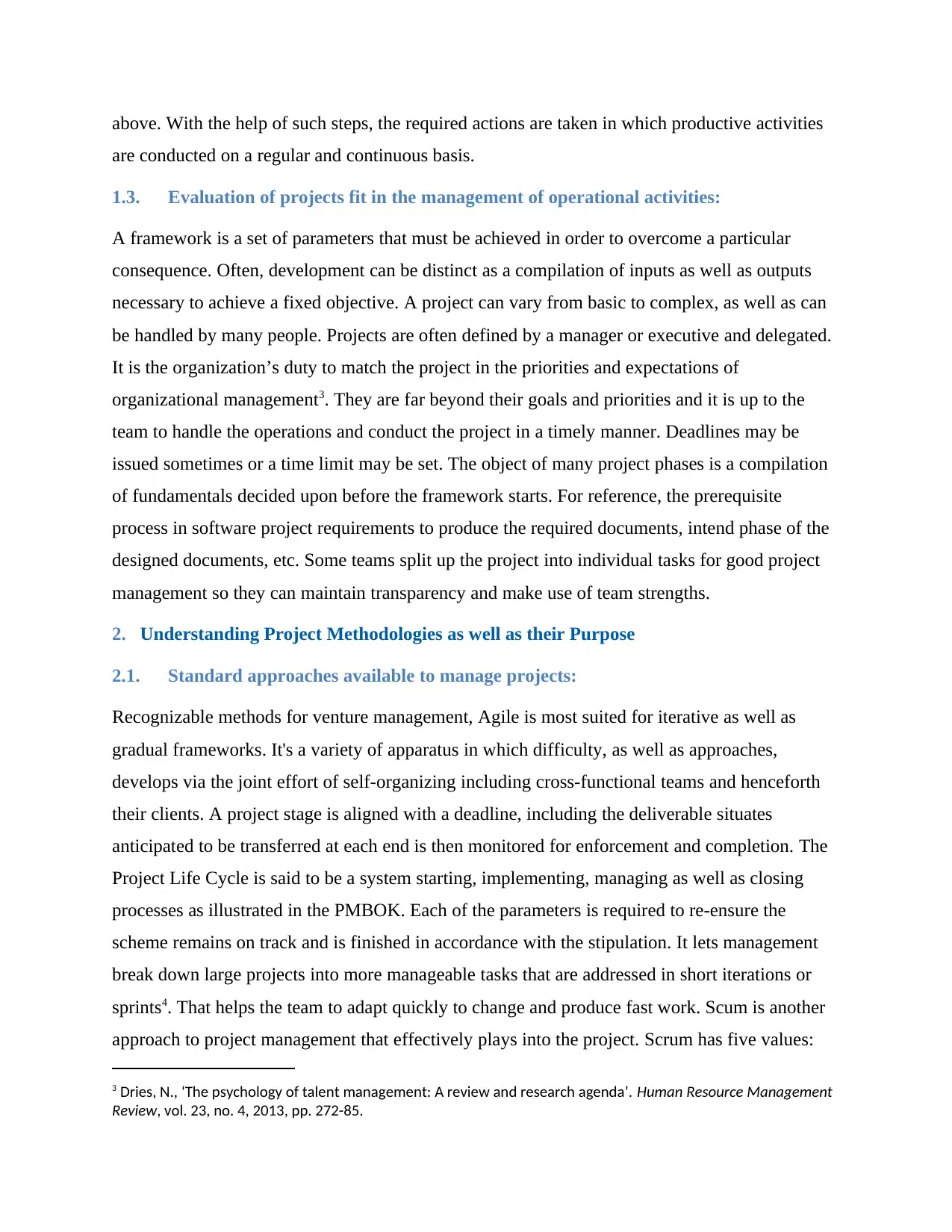
above. With the help of such steps, the required actions are taken in which productive activities
are conducted on a regular and continuous basis.
1.3. Evaluation of projects fit in the management of operational activities:
A framework is a set of parameters that must be achieved in order to overcome a particular
consequence. Often, development can be distinct as a compilation of inputs as well as outputs
necessary to achieve a fixed objective. A project can vary from basic to complex, as well as can
be handled by many people. Projects are often defined by a manager or executive and delegated.
It is the organization’s duty to match the project in the priorities and expectations of
organizational management3. They are far beyond their goals and priorities and it is up to the
team to handle the operations and conduct the project in a timely manner. Deadlines may be
issued sometimes or a time limit may be set. The object of many project phases is a compilation
of fundamentals decided upon before the framework starts. For reference, the prerequisite
process in software project requirements to produce the required documents, intend phase of the
designed documents, etc. Some teams split up the project into individual tasks for good project
management so they can maintain transparency and make use of team strengths.
2. Understanding Project Methodologies as well as their Purpose
2.1. Standard approaches available to manage projects:
Recognizable methods for venture management, Agile is most suited for iterative as well as
gradual frameworks. It's a variety of apparatus in which difficulty, as well as approaches,
develops via the joint effort of self-organizing including cross-functional teams and henceforth
their clients. A project stage is aligned with a deadline, including the deliverable situates
anticipated to be transferred at each end is then monitored for enforcement and completion. The
Project Life Cycle is said to be a system starting, implementing, managing as well as closing
processes as illustrated in the PMBOK. Each of the parameters is required to re-ensure the
scheme remains on track and is finished in accordance with the stipulation. It lets management
break down large projects into more manageable tasks that are addressed in short iterations or
sprints4. That helps the team to adapt quickly to change and produce fast work. Scum is another
approach to project management that effectively plays into the project. Scrum has five values:
3 Dries, N., ‘The psychology of talent management: A review and research agenda’. Human Resource Management
Review, vol. 23, no. 4, 2013, pp. 272-85.
are conducted on a regular and continuous basis.
1.3. Evaluation of projects fit in the management of operational activities:
A framework is a set of parameters that must be achieved in order to overcome a particular
consequence. Often, development can be distinct as a compilation of inputs as well as outputs
necessary to achieve a fixed objective. A project can vary from basic to complex, as well as can
be handled by many people. Projects are often defined by a manager or executive and delegated.
It is the organization’s duty to match the project in the priorities and expectations of
organizational management3. They are far beyond their goals and priorities and it is up to the
team to handle the operations and conduct the project in a timely manner. Deadlines may be
issued sometimes or a time limit may be set. The object of many project phases is a compilation
of fundamentals decided upon before the framework starts. For reference, the prerequisite
process in software project requirements to produce the required documents, intend phase of the
designed documents, etc. Some teams split up the project into individual tasks for good project
management so they can maintain transparency and make use of team strengths.
2. Understanding Project Methodologies as well as their Purpose
2.1. Standard approaches available to manage projects:
Recognizable methods for venture management, Agile is most suited for iterative as well as
gradual frameworks. It's a variety of apparatus in which difficulty, as well as approaches,
develops via the joint effort of self-organizing including cross-functional teams and henceforth
their clients. A project stage is aligned with a deadline, including the deliverable situates
anticipated to be transferred at each end is then monitored for enforcement and completion. The
Project Life Cycle is said to be a system starting, implementing, managing as well as closing
processes as illustrated in the PMBOK. Each of the parameters is required to re-ensure the
scheme remains on track and is finished in accordance with the stipulation. It lets management
break down large projects into more manageable tasks that are addressed in short iterations or
sprints4. That helps the team to adapt quickly to change and produce fast work. Scum is another
approach to project management that effectively plays into the project. Scrum has five values:
3 Dries, N., ‘The psychology of talent management: A review and research agenda’. Human Resource Management
Review, vol. 23, no. 4, 2013, pp. 272-85.
Paraphrase This Document
Need a fresh take? Get an instant paraphrase of this document with our AI Paraphraser
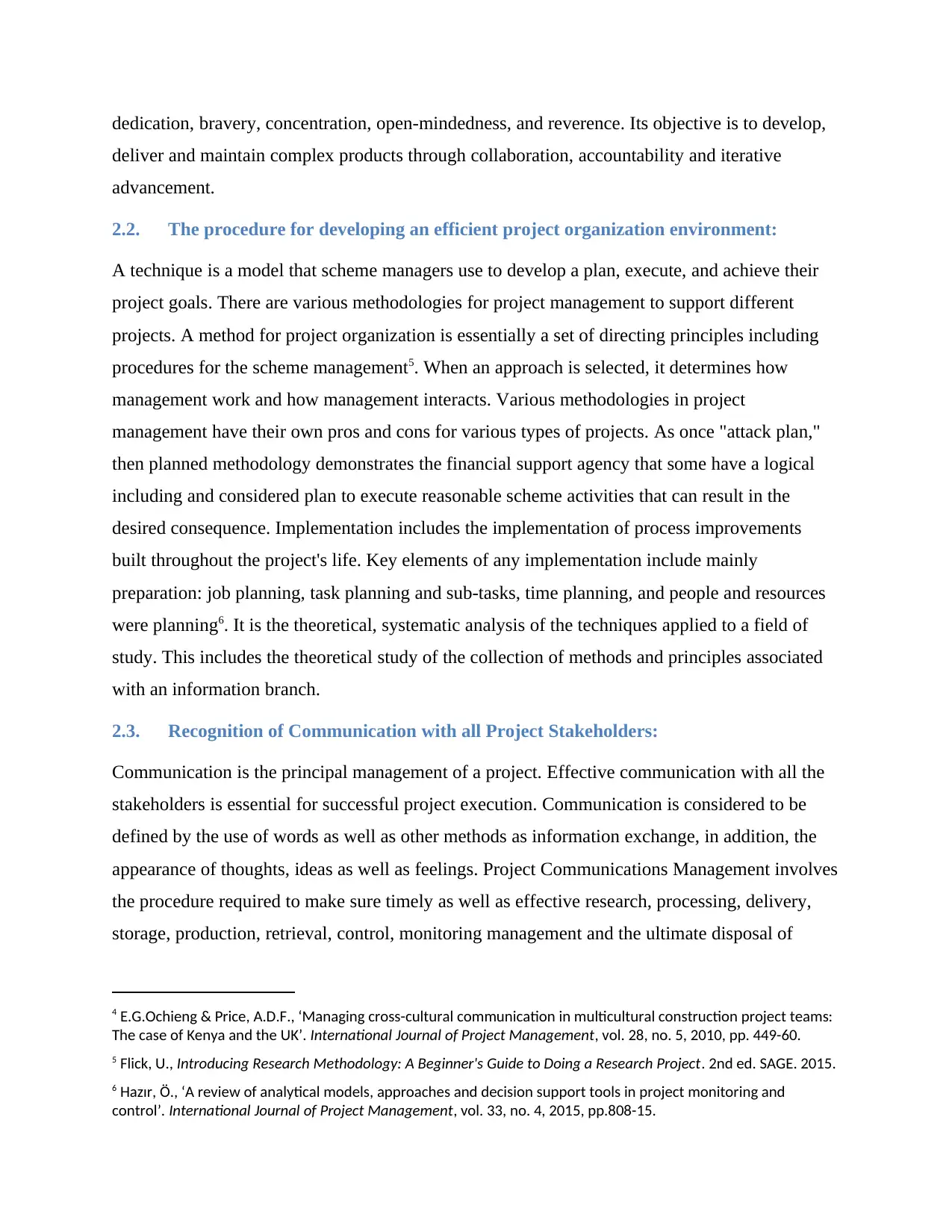
dedication, bravery, concentration, open-mindedness, and reverence. Its objective is to develop,
deliver and maintain complex products through collaboration, accountability and iterative
advancement.
2.2. The procedure for developing an efficient project organization environment:
A technique is a model that scheme managers use to develop a plan, execute, and achieve their
project goals. There are various methodologies for project management to support different
projects. A method for project organization is essentially a set of directing principles including
procedures for the scheme management5. When an approach is selected, it determines how
management work and how management interacts. Various methodologies in project
management have their own pros and cons for various types of projects. As once "attack plan,"
then planned methodology demonstrates the financial support agency that some have a logical
including and considered plan to execute reasonable scheme activities that can result in the
desired consequence. Implementation includes the implementation of process improvements
built throughout the project's life. Key elements of any implementation include mainly
preparation: job planning, task planning and sub-tasks, time planning, and people and resources
were planning6. It is the theoretical, systematic analysis of the techniques applied to a field of
study. This includes the theoretical study of the collection of methods and principles associated
with an information branch.
2.3. Recognition of Communication with all Project Stakeholders:
Communication is the principal management of a project. Effective communication with all the
stakeholders is essential for successful project execution. Communication is considered to be
defined by the use of words as well as other methods as information exchange, in addition, the
appearance of thoughts, ideas as well as feelings. Project Communications Management involves
the procedure required to make sure timely as well as effective research, processing, delivery,
storage, production, retrieval, control, monitoring management and the ultimate disposal of
4 E.G.Ochieng & Price, A.D.F., ‘Managing cross-cultural communication in multicultural construction project teams:
The case of Kenya and the UK’. International Journal of Project Management, vol. 28, no. 5, 2010, pp. 449-60.
5 Flick, U., Introducing Research Methodology: A Beginner's Guide to Doing a Research Project. 2nd ed. SAGE. 2015.
6 Hazır, Ö., ‘A review of analytical models, approaches and decision support tools in project monitoring and
control’. International Journal of Project Management, vol. 33, no. 4, 2015, pp.808-15.
deliver and maintain complex products through collaboration, accountability and iterative
advancement.
2.2. The procedure for developing an efficient project organization environment:
A technique is a model that scheme managers use to develop a plan, execute, and achieve their
project goals. There are various methodologies for project management to support different
projects. A method for project organization is essentially a set of directing principles including
procedures for the scheme management5. When an approach is selected, it determines how
management work and how management interacts. Various methodologies in project
management have their own pros and cons for various types of projects. As once "attack plan,"
then planned methodology demonstrates the financial support agency that some have a logical
including and considered plan to execute reasonable scheme activities that can result in the
desired consequence. Implementation includes the implementation of process improvements
built throughout the project's life. Key elements of any implementation include mainly
preparation: job planning, task planning and sub-tasks, time planning, and people and resources
were planning6. It is the theoretical, systematic analysis of the techniques applied to a field of
study. This includes the theoretical study of the collection of methods and principles associated
with an information branch.
2.3. Recognition of Communication with all Project Stakeholders:
Communication is the principal management of a project. Effective communication with all the
stakeholders is essential for successful project execution. Communication is considered to be
defined by the use of words as well as other methods as information exchange, in addition, the
appearance of thoughts, ideas as well as feelings. Project Communications Management involves
the procedure required to make sure timely as well as effective research, processing, delivery,
storage, production, retrieval, control, monitoring management and the ultimate disposal of
4 E.G.Ochieng & Price, A.D.F., ‘Managing cross-cultural communication in multicultural construction project teams:
The case of Kenya and the UK’. International Journal of Project Management, vol. 28, no. 5, 2010, pp. 449-60.
5 Flick, U., Introducing Research Methodology: A Beginner's Guide to Doing a Research Project. 2nd ed. SAGE. 2015.
6 Hazır, Ö., ‘A review of analytical models, approaches and decision support tools in project monitoring and
control’. International Journal of Project Management, vol. 33, no. 4, 2015, pp.808-15.
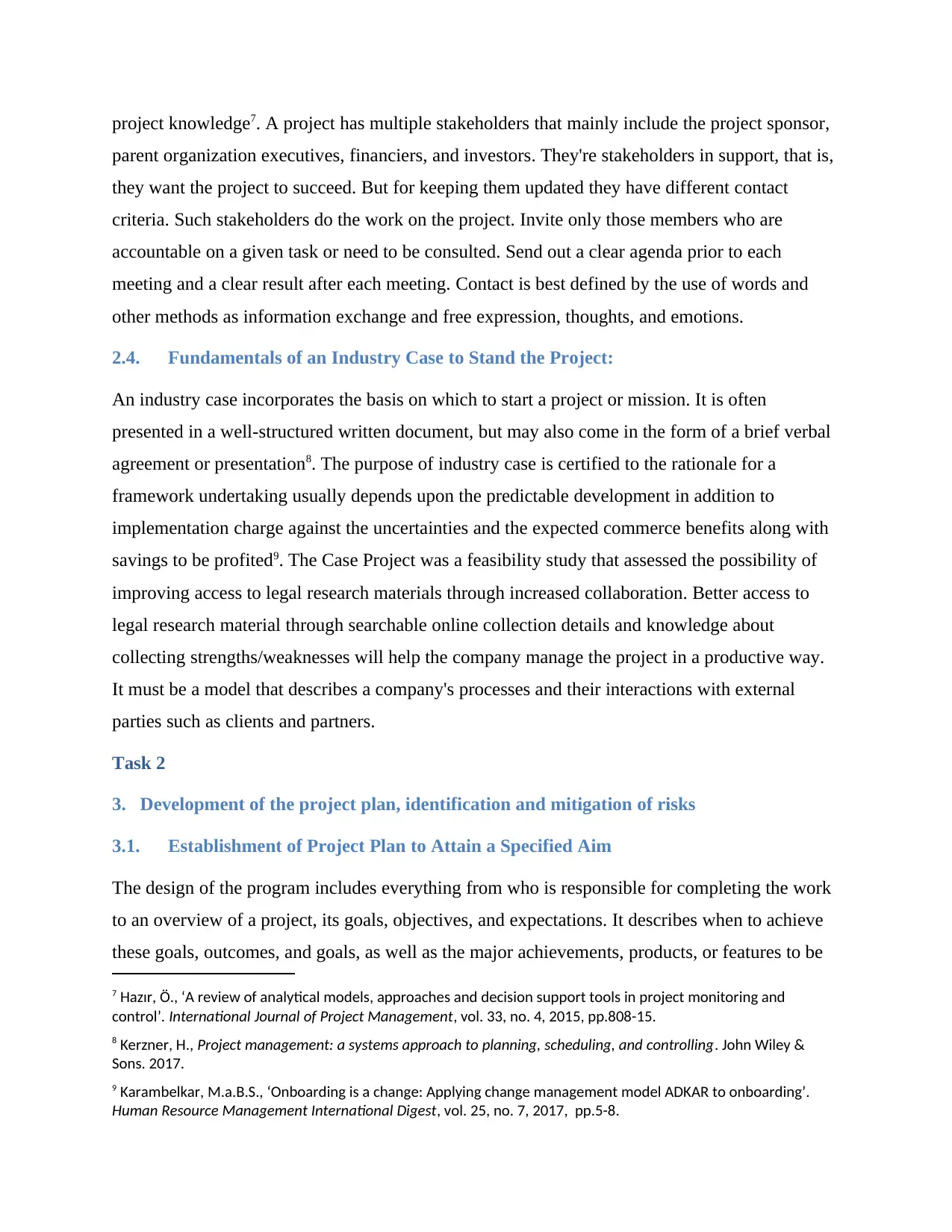
project knowledge7. A project has multiple stakeholders that mainly include the project sponsor,
parent organization executives, financiers, and investors. They're stakeholders in support, that is,
they want the project to succeed. But for keeping them updated they have different contact
criteria. Such stakeholders do the work on the project. Invite only those members who are
accountable on a given task or need to be consulted. Send out a clear agenda prior to each
meeting and a clear result after each meeting. Contact is best defined by the use of words and
other methods as information exchange and free expression, thoughts, and emotions.
2.4. Fundamentals of an Industry Case to Stand the Project:
An industry case incorporates the basis on which to start a project or mission. It is often
presented in a well-structured written document, but may also come in the form of a brief verbal
agreement or presentation8. The purpose of industry case is certified to the rationale for a
framework undertaking usually depends upon the predictable development in addition to
implementation charge against the uncertainties and the expected commerce benefits along with
savings to be profited9. The Case Project was a feasibility study that assessed the possibility of
improving access to legal research materials through increased collaboration. Better access to
legal research material through searchable online collection details and knowledge about
collecting strengths/weaknesses will help the company manage the project in a productive way.
It must be a model that describes a company's processes and their interactions with external
parties such as clients and partners.
Task 2
3. Development of the project plan, identification and mitigation of risks
3.1. Establishment of Project Plan to Attain a Specified Aim
The design of the program includes everything from who is responsible for completing the work
to an overview of a project, its goals, objectives, and expectations. It describes when to achieve
these goals, outcomes, and goals, as well as the major achievements, products, or features to be
7 Hazır, Ö., ‘A review of analytical models, approaches and decision support tools in project monitoring and
control’. International Journal of Project Management, vol. 33, no. 4, 2015, pp.808-15.
8 Kerzner, H., Project management: a systems approach to planning, scheduling, and controlling. John Wiley &
Sons. 2017.
9 Karambelkar, M.a.B.S., ‘Onboarding is a change: Applying change management model ADKAR to onboarding’.
Human Resource Management International Digest, vol. 25, no. 7, 2017, pp.5-8.
parent organization executives, financiers, and investors. They're stakeholders in support, that is,
they want the project to succeed. But for keeping them updated they have different contact
criteria. Such stakeholders do the work on the project. Invite only those members who are
accountable on a given task or need to be consulted. Send out a clear agenda prior to each
meeting and a clear result after each meeting. Contact is best defined by the use of words and
other methods as information exchange and free expression, thoughts, and emotions.
2.4. Fundamentals of an Industry Case to Stand the Project:
An industry case incorporates the basis on which to start a project or mission. It is often
presented in a well-structured written document, but may also come in the form of a brief verbal
agreement or presentation8. The purpose of industry case is certified to the rationale for a
framework undertaking usually depends upon the predictable development in addition to
implementation charge against the uncertainties and the expected commerce benefits along with
savings to be profited9. The Case Project was a feasibility study that assessed the possibility of
improving access to legal research materials through increased collaboration. Better access to
legal research material through searchable online collection details and knowledge about
collecting strengths/weaknesses will help the company manage the project in a productive way.
It must be a model that describes a company's processes and their interactions with external
parties such as clients and partners.
Task 2
3. Development of the project plan, identification and mitigation of risks
3.1. Establishment of Project Plan to Attain a Specified Aim
The design of the program includes everything from who is responsible for completing the work
to an overview of a project, its goals, objectives, and expectations. It describes when to achieve
these goals, outcomes, and goals, as well as the major achievements, products, or features to be
7 Hazır, Ö., ‘A review of analytical models, approaches and decision support tools in project monitoring and
control’. International Journal of Project Management, vol. 33, no. 4, 2015, pp.808-15.
8 Kerzner, H., Project management: a systems approach to planning, scheduling, and controlling. John Wiley &
Sons. 2017.
9 Karambelkar, M.a.B.S., ‘Onboarding is a change: Applying change management model ADKAR to onboarding’.
Human Resource Management International Digest, vol. 25, no. 7, 2017, pp.5-8.
⊘ This is a preview!⊘
Do you want full access?
Subscribe today to unlock all pages.

Trusted by 1+ million students worldwide
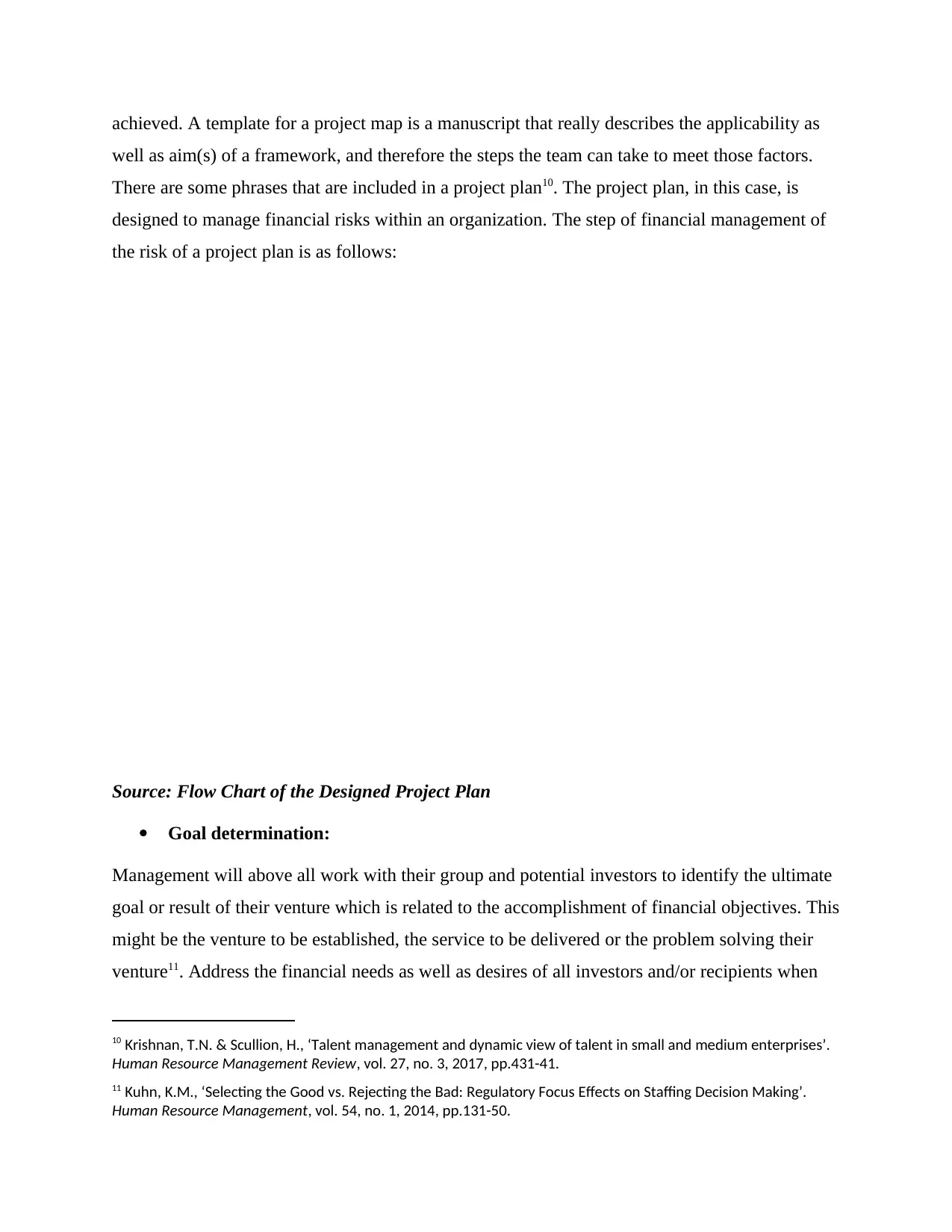
achieved. A template for a project map is a manuscript that really describes the applicability as
well as aim(s) of a framework, and therefore the steps the team can take to meet those factors.
There are some phrases that are included in a project plan10. The project plan, in this case, is
designed to manage financial risks within an organization. The step of financial management of
the risk of a project plan is as follows:
Source: Flow Chart of the Designed Project Plan
Goal determination:
Management will above all work with their group and potential investors to identify the ultimate
goal or result of their venture which is related to the accomplishment of financial objectives. This
might be the venture to be established, the service to be delivered or the problem solving their
venture11. Address the financial needs as well as desires of all investors and/or recipients when
10 Krishnan, T.N. & Scullion, H., ‘Talent management and dynamic view of talent in small and medium enterprises’.
Human Resource Management Review, vol. 27, no. 3, 2017, pp.431-41.
11 Kuhn, K.M., ‘Selecting the Good vs. Rejecting the Bad: Regulatory Focus Effects on Staffing Decision Making’.
Human Resource Management, vol. 54, no. 1, 2014, pp.131-50.
GoalDeterminationDefiningStrategiesIdentifyingThePlanRiskAndBenefitsIdentificationImplementationOfThePlanAssessmentOfThePlan
well as aim(s) of a framework, and therefore the steps the team can take to meet those factors.
There are some phrases that are included in a project plan10. The project plan, in this case, is
designed to manage financial risks within an organization. The step of financial management of
the risk of a project plan is as follows:
Source: Flow Chart of the Designed Project Plan
Goal determination:
Management will above all work with their group and potential investors to identify the ultimate
goal or result of their venture which is related to the accomplishment of financial objectives. This
might be the venture to be established, the service to be delivered or the problem solving their
venture11. Address the financial needs as well as desires of all investors and/or recipients when
10 Krishnan, T.N. & Scullion, H., ‘Talent management and dynamic view of talent in small and medium enterprises’.
Human Resource Management Review, vol. 27, no. 3, 2017, pp.431-41.
11 Kuhn, K.M., ‘Selecting the Good vs. Rejecting the Bad: Regulatory Focus Effects on Staffing Decision Making’.
Human Resource Management, vol. 54, no. 1, 2014, pp.131-50.
GoalDeterminationDefiningStrategiesIdentifyingThePlanRiskAndBenefitsIdentificationImplementationOfThePlanAssessmentOfThePlan
Paraphrase This Document
Need a fresh take? Get an instant paraphrase of this document with our AI Paraphraser
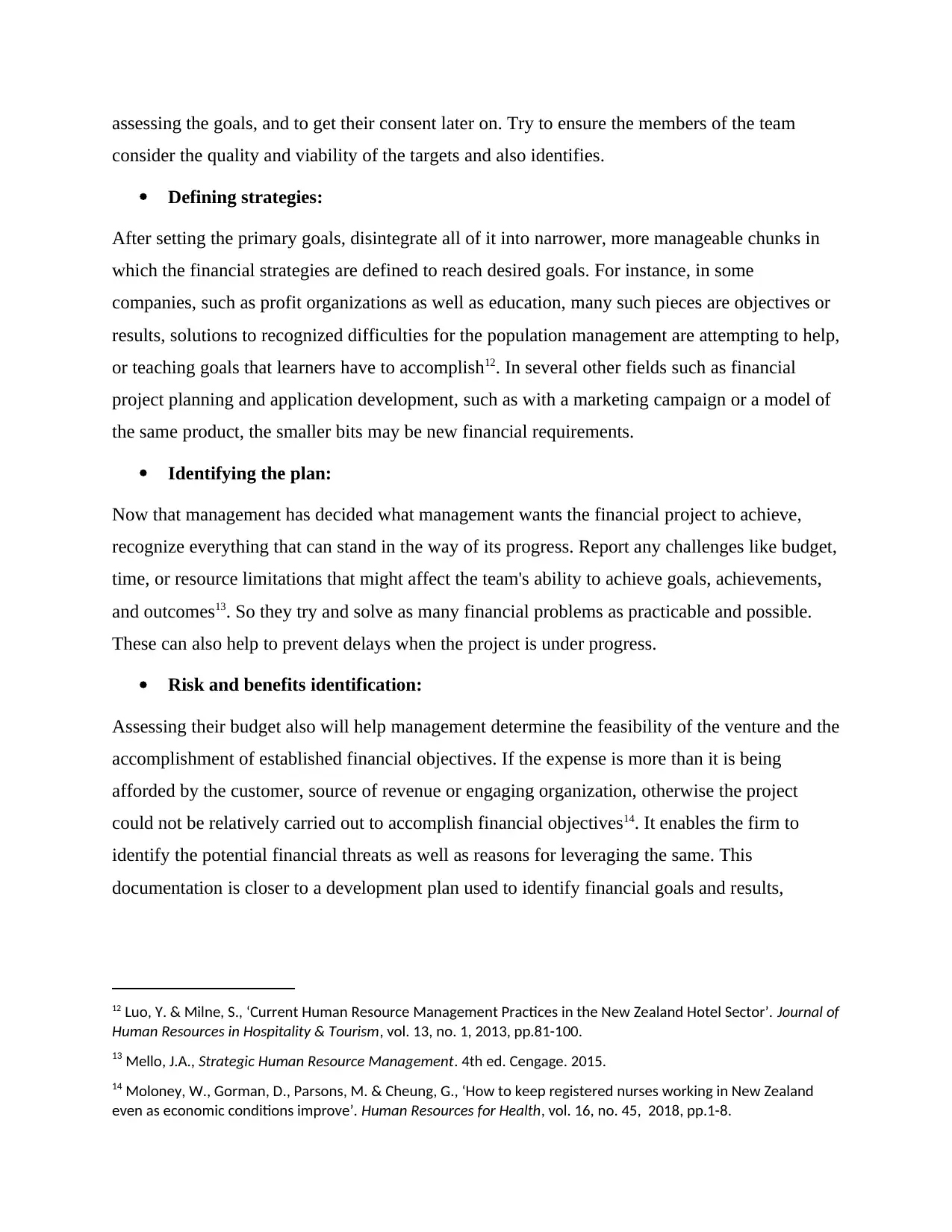
assessing the goals, and to get their consent later on. Try to ensure the members of the team
consider the quality and viability of the targets and also identifies.
Defining strategies:
After setting the primary goals, disintegrate all of it into narrower, more manageable chunks in
which the financial strategies are defined to reach desired goals. For instance, in some
companies, such as profit organizations as well as education, many such pieces are objectives or
results, solutions to recognized difficulties for the population management are attempting to help,
or teaching goals that learners have to accomplish12. In several other fields such as financial
project planning and application development, such as with a marketing campaign or a model of
the same product, the smaller bits may be new financial requirements.
Identifying the plan:
Now that management has decided what management wants the financial project to achieve,
recognize everything that can stand in the way of its progress. Report any challenges like budget,
time, or resource limitations that might affect the team's ability to achieve goals, achievements,
and outcomes13. So they try and solve as many financial problems as practicable and possible.
These can also help to prevent delays when the project is under progress.
Risk and benefits identification:
Assessing their budget also will help management determine the feasibility of the venture and the
accomplishment of established financial objectives. If the expense is more than it is being
afforded by the customer, source of revenue or engaging organization, otherwise the project
could not be relatively carried out to accomplish financial objectives14. It enables the firm to
identify the potential financial threats as well as reasons for leveraging the same. This
documentation is closer to a development plan used to identify financial goals and results,
12 Luo, Y. & Milne, S., ‘Current Human Resource Management Practices in the New Zealand Hotel Sector’. Journal of
Human Resources in Hospitality & Tourism, vol. 13, no. 1, 2013, pp.81-100.
13 Mello, J.A., Strategic Human Resource Management. 4th ed. Cengage. 2015.
14 Moloney, W., Gorman, D., Parsons, M. & Cheung, G., ‘How to keep registered nurses working in New Zealand
even as economic conditions improve’. Human Resources for Health, vol. 16, no. 45, 2018, pp.1-8.
consider the quality and viability of the targets and also identifies.
Defining strategies:
After setting the primary goals, disintegrate all of it into narrower, more manageable chunks in
which the financial strategies are defined to reach desired goals. For instance, in some
companies, such as profit organizations as well as education, many such pieces are objectives or
results, solutions to recognized difficulties for the population management are attempting to help,
or teaching goals that learners have to accomplish12. In several other fields such as financial
project planning and application development, such as with a marketing campaign or a model of
the same product, the smaller bits may be new financial requirements.
Identifying the plan:
Now that management has decided what management wants the financial project to achieve,
recognize everything that can stand in the way of its progress. Report any challenges like budget,
time, or resource limitations that might affect the team's ability to achieve goals, achievements,
and outcomes13. So they try and solve as many financial problems as practicable and possible.
These can also help to prevent delays when the project is under progress.
Risk and benefits identification:
Assessing their budget also will help management determine the feasibility of the venture and the
accomplishment of established financial objectives. If the expense is more than it is being
afforded by the customer, source of revenue or engaging organization, otherwise the project
could not be relatively carried out to accomplish financial objectives14. It enables the firm to
identify the potential financial threats as well as reasons for leveraging the same. This
documentation is closer to a development plan used to identify financial goals and results,
12 Luo, Y. & Milne, S., ‘Current Human Resource Management Practices in the New Zealand Hotel Sector’. Journal of
Human Resources in Hospitality & Tourism, vol. 13, no. 1, 2013, pp.81-100.
13 Mello, J.A., Strategic Human Resource Management. 4th ed. Cengage. 2015.
14 Moloney, W., Gorman, D., Parsons, M. & Cheung, G., ‘How to keep registered nurses working in New Zealand
even as economic conditions improve’. Human Resources for Health, vol. 16, no. 45, 2018, pp.1-8.
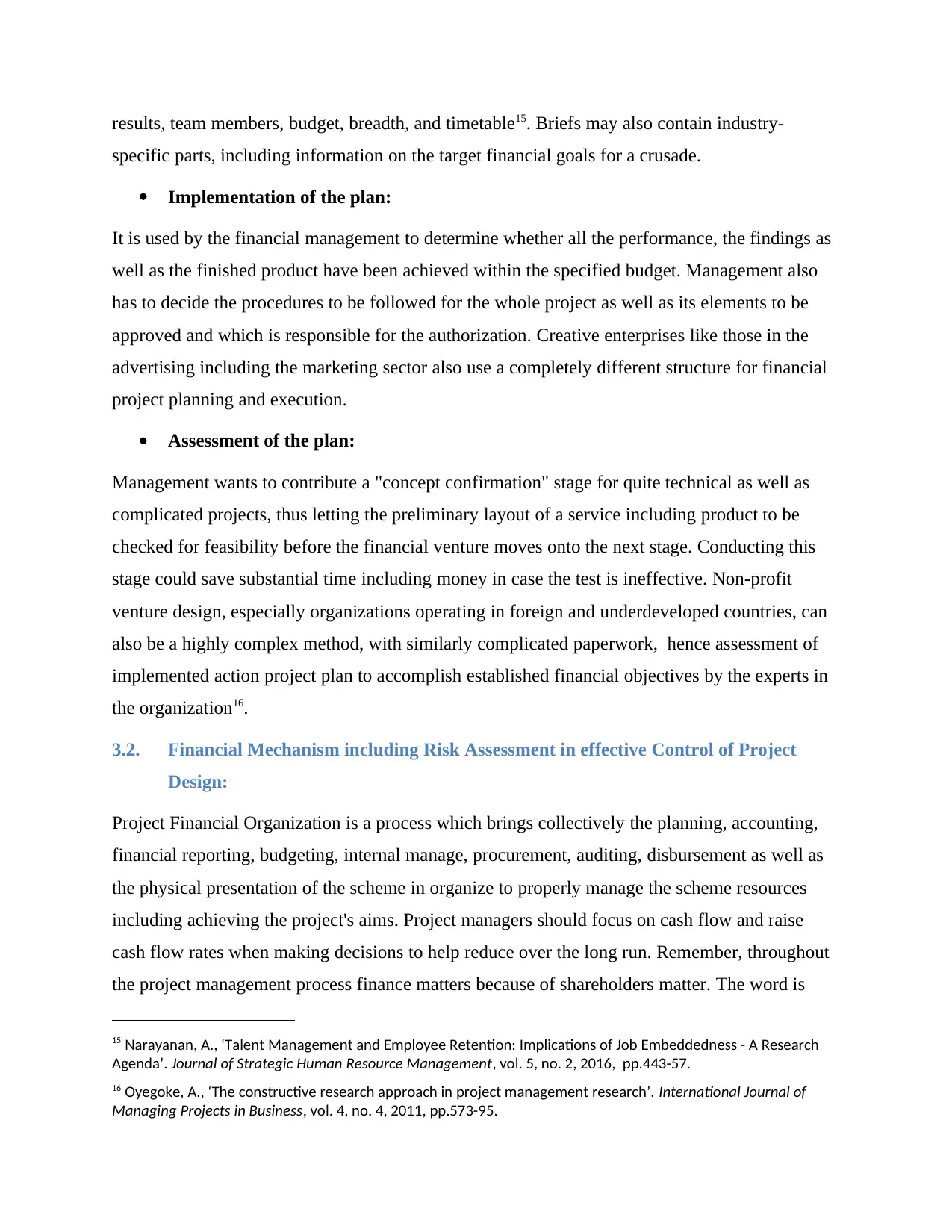
results, team members, budget, breadth, and timetable15. Briefs may also contain industry-
specific parts, including information on the target financial goals for a crusade.
Implementation of the plan:
It is used by the financial management to determine whether all the performance, the findings as
well as the finished product have been achieved within the specified budget. Management also
has to decide the procedures to be followed for the whole project as well as its elements to be
approved and which is responsible for the authorization. Creative enterprises like those in the
advertising including the marketing sector also use a completely different structure for financial
project planning and execution.
Assessment of the plan:
Management wants to contribute a "concept confirmation" stage for quite technical as well as
complicated projects, thus letting the preliminary layout of a service including product to be
checked for feasibility before the financial venture moves onto the next stage. Conducting this
stage could save substantial time including money in case the test is ineffective. Non-profit
venture design, especially organizations operating in foreign and underdeveloped countries, can
also be a highly complex method, with similarly complicated paperwork, hence assessment of
implemented action project plan to accomplish established financial objectives by the experts in
the organization16.
3.2. Financial Mechanism including Risk Assessment in effective Control of Project
Design:
Project Financial Organization is a process which brings collectively the planning, accounting,
financial reporting, budgeting, internal manage, procurement, auditing, disbursement as well as
the physical presentation of the scheme in organize to properly manage the scheme resources
including achieving the project's aims. Project managers should focus on cash flow and raise
cash flow rates when making decisions to help reduce over the long run. Remember, throughout
the project management process finance matters because of shareholders matter. The word is
15 Narayanan, A., ‘Talent Management and Employee Retention: Implications of Job Embeddedness - A Research
Agenda’. Journal of Strategic Human Resource Management, vol. 5, no. 2, 2016, pp.443-57.
16 Oyegoke, A., ‘The constructive research approach in project management research’. International Journal of
Managing Projects in Business, vol. 4, no. 4, 2011, pp.573-95.
specific parts, including information on the target financial goals for a crusade.
Implementation of the plan:
It is used by the financial management to determine whether all the performance, the findings as
well as the finished product have been achieved within the specified budget. Management also
has to decide the procedures to be followed for the whole project as well as its elements to be
approved and which is responsible for the authorization. Creative enterprises like those in the
advertising including the marketing sector also use a completely different structure for financial
project planning and execution.
Assessment of the plan:
Management wants to contribute a "concept confirmation" stage for quite technical as well as
complicated projects, thus letting the preliminary layout of a service including product to be
checked for feasibility before the financial venture moves onto the next stage. Conducting this
stage could save substantial time including money in case the test is ineffective. Non-profit
venture design, especially organizations operating in foreign and underdeveloped countries, can
also be a highly complex method, with similarly complicated paperwork, hence assessment of
implemented action project plan to accomplish established financial objectives by the experts in
the organization16.
3.2. Financial Mechanism including Risk Assessment in effective Control of Project
Design:
Project Financial Organization is a process which brings collectively the planning, accounting,
financial reporting, budgeting, internal manage, procurement, auditing, disbursement as well as
the physical presentation of the scheme in organize to properly manage the scheme resources
including achieving the project's aims. Project managers should focus on cash flow and raise
cash flow rates when making decisions to help reduce over the long run. Remember, throughout
the project management process finance matters because of shareholders matter. The word is
15 Narayanan, A., ‘Talent Management and Employee Retention: Implications of Job Embeddedness - A Research
Agenda’. Journal of Strategic Human Resource Management, vol. 5, no. 2, 2016, pp.443-57.
16 Oyegoke, A., ‘The constructive research approach in project management research’. International Journal of
Managing Projects in Business, vol. 4, no. 4, 2011, pp.573-95.
⊘ This is a preview!⊘
Do you want full access?
Subscribe today to unlock all pages.

Trusted by 1+ million students worldwide
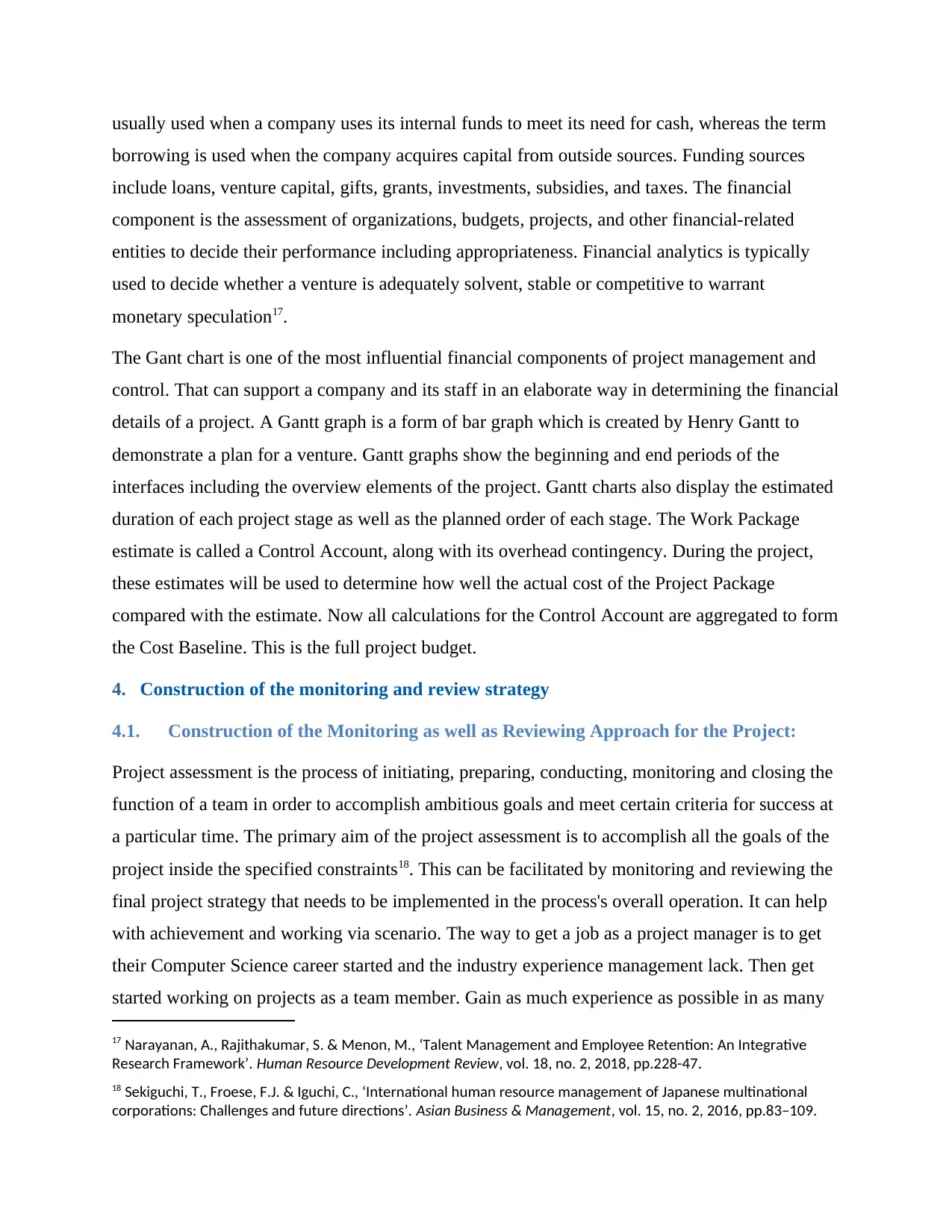
usually used when a company uses its internal funds to meet its need for cash, whereas the term
borrowing is used when the company acquires capital from outside sources. Funding sources
include loans, venture capital, gifts, grants, investments, subsidies, and taxes. The financial
component is the assessment of organizations, budgets, projects, and other financial-related
entities to decide their performance including appropriateness. Financial analytics is typically
used to decide whether a venture is adequately solvent, stable or competitive to warrant
monetary speculation17.
The Gant chart is one of the most influential financial components of project management and
control. That can support a company and its staff in an elaborate way in determining the financial
details of a project. A Gantt graph is a form of bar graph which is created by Henry Gantt to
demonstrate a plan for a venture. Gantt graphs show the beginning and end periods of the
interfaces including the overview elements of the project. Gantt charts also display the estimated
duration of each project stage as well as the planned order of each stage. The Work Package
estimate is called a Control Account, along with its overhead contingency. During the project,
these estimates will be used to determine how well the actual cost of the Project Package
compared with the estimate. Now all calculations for the Control Account are aggregated to form
the Cost Baseline. This is the full project budget.
4. Construction of the monitoring and review strategy
4.1. Construction of the Monitoring as well as Reviewing Approach for the Project:
Project assessment is the process of initiating, preparing, conducting, monitoring and closing the
function of a team in order to accomplish ambitious goals and meet certain criteria for success at
a particular time. The primary aim of the project assessment is to accomplish all the goals of the
project inside the specified constraints18. This can be facilitated by monitoring and reviewing the
final project strategy that needs to be implemented in the process's overall operation. It can help
with achievement and working via scenario. The way to get a job as a project manager is to get
their Computer Science career started and the industry experience management lack. Then get
started working on projects as a team member. Gain as much experience as possible in as many
17 Narayanan, A., Rajithakumar, S. & Menon, M., ‘Talent Management and Employee Retention: An Integrative
Research Framework’. Human Resource Development Review, vol. 18, no. 2, 2018, pp.228-47.
18 Sekiguchi, T., Froese, F.J. & Iguchi, C., ‘International human resource management of Japanese multinational
corporations: Challenges and future directions’. Asian Business & Management, vol. 15, no. 2, 2016, pp.83–109.
borrowing is used when the company acquires capital from outside sources. Funding sources
include loans, venture capital, gifts, grants, investments, subsidies, and taxes. The financial
component is the assessment of organizations, budgets, projects, and other financial-related
entities to decide their performance including appropriateness. Financial analytics is typically
used to decide whether a venture is adequately solvent, stable or competitive to warrant
monetary speculation17.
The Gant chart is one of the most influential financial components of project management and
control. That can support a company and its staff in an elaborate way in determining the financial
details of a project. A Gantt graph is a form of bar graph which is created by Henry Gantt to
demonstrate a plan for a venture. Gantt graphs show the beginning and end periods of the
interfaces including the overview elements of the project. Gantt charts also display the estimated
duration of each project stage as well as the planned order of each stage. The Work Package
estimate is called a Control Account, along with its overhead contingency. During the project,
these estimates will be used to determine how well the actual cost of the Project Package
compared with the estimate. Now all calculations for the Control Account are aggregated to form
the Cost Baseline. This is the full project budget.
4. Construction of the monitoring and review strategy
4.1. Construction of the Monitoring as well as Reviewing Approach for the Project:
Project assessment is the process of initiating, preparing, conducting, monitoring and closing the
function of a team in order to accomplish ambitious goals and meet certain criteria for success at
a particular time. The primary aim of the project assessment is to accomplish all the goals of the
project inside the specified constraints18. This can be facilitated by monitoring and reviewing the
final project strategy that needs to be implemented in the process's overall operation. It can help
with achievement and working via scenario. The way to get a job as a project manager is to get
their Computer Science career started and the industry experience management lack. Then get
started working on projects as a team member. Gain as much experience as possible in as many
17 Narayanan, A., Rajithakumar, S. & Menon, M., ‘Talent Management and Employee Retention: An Integrative
Research Framework’. Human Resource Development Review, vol. 18, no. 2, 2018, pp.228-47.
18 Sekiguchi, T., Froese, F.J. & Iguchi, C., ‘International human resource management of Japanese multinational
corporations: Challenges and future directions’. Asian Business & Management, vol. 15, no. 2, 2016, pp.83–109.
Paraphrase This Document
Need a fresh take? Get an instant paraphrase of this document with our AI Paraphraser
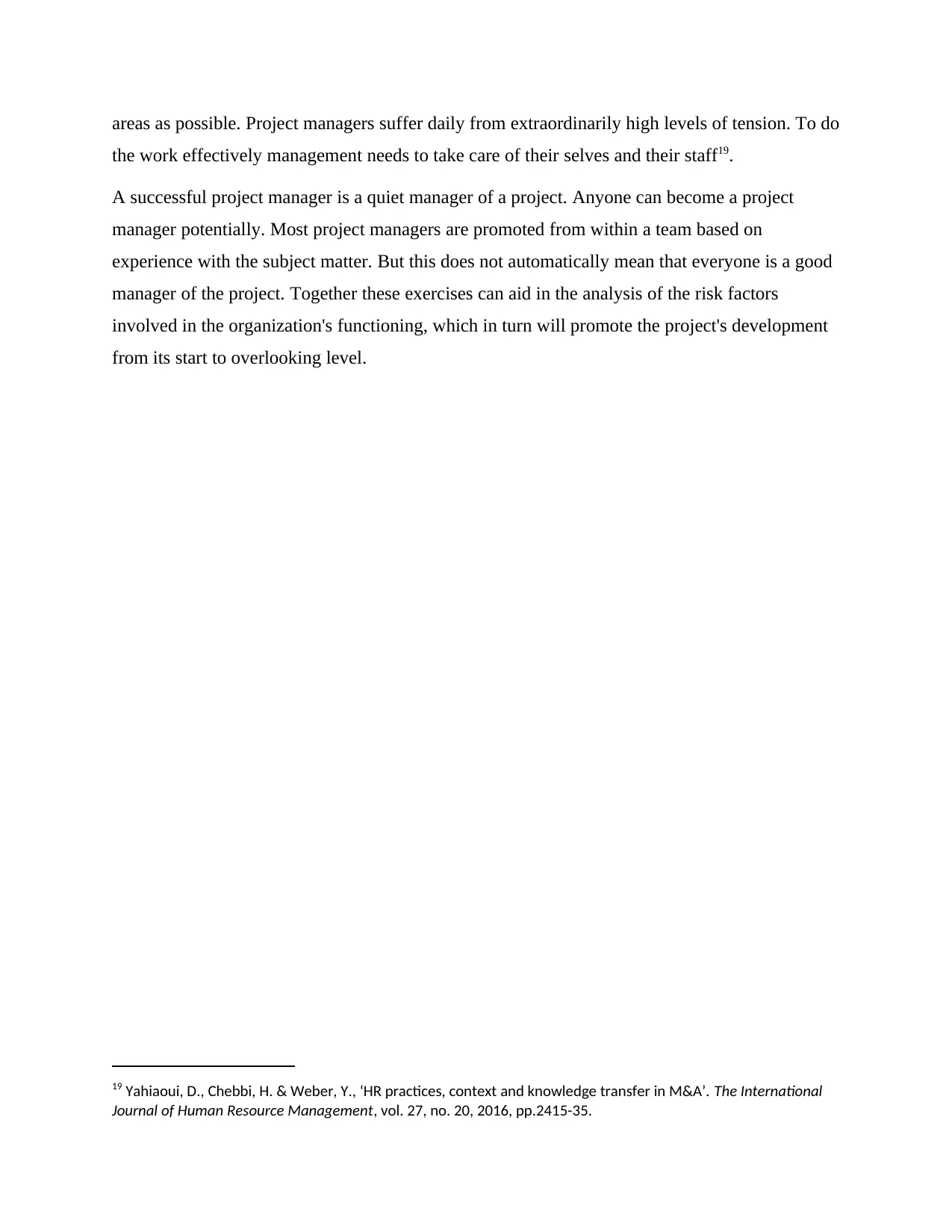
areas as possible. Project managers suffer daily from extraordinarily high levels of tension. To do
the work effectively management needs to take care of their selves and their staff19.
A successful project manager is a quiet manager of a project. Anyone can become a project
manager potentially. Most project managers are promoted from within a team based on
experience with the subject matter. But this does not automatically mean that everyone is a good
manager of the project. Together these exercises can aid in the analysis of the risk factors
involved in the organization's functioning, which in turn will promote the project's development
from its start to overlooking level.
19 Yahiaoui, D., Chebbi, H. & Weber, Y., ‘HR practices, context and knowledge transfer in M&A’. The International
Journal of Human Resource Management, vol. 27, no. 20, 2016, pp.2415-35.
the work effectively management needs to take care of their selves and their staff19.
A successful project manager is a quiet manager of a project. Anyone can become a project
manager potentially. Most project managers are promoted from within a team based on
experience with the subject matter. But this does not automatically mean that everyone is a good
manager of the project. Together these exercises can aid in the analysis of the risk factors
involved in the organization's functioning, which in turn will promote the project's development
from its start to overlooking level.
19 Yahiaoui, D., Chebbi, H. & Weber, Y., ‘HR practices, context and knowledge transfer in M&A’. The International
Journal of Human Resource Management, vol. 27, no. 20, 2016, pp.2415-35.
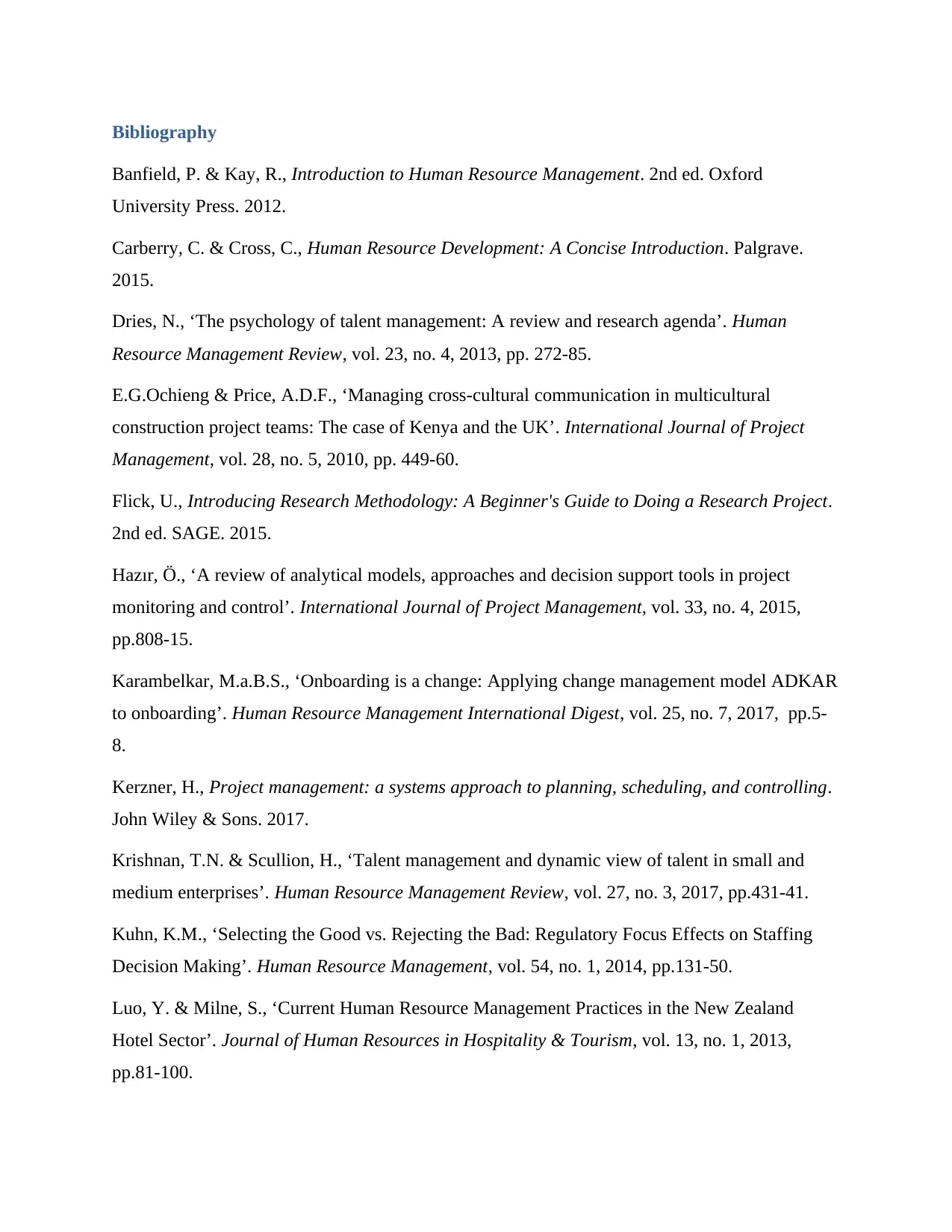
Bibliography
Banfield, P. & Kay, R., Introduction to Human Resource Management. 2nd ed. Oxford
University Press. 2012.
Carberry, C. & Cross, C., Human Resource Development: A Concise Introduction. Palgrave.
2015.
Dries, N., ‘The psychology of talent management: A review and research agenda’. Human
Resource Management Review, vol. 23, no. 4, 2013, pp. 272-85.
E.G.Ochieng & Price, A.D.F., ‘Managing cross-cultural communication in multicultural
construction project teams: The case of Kenya and the UK’. International Journal of Project
Management, vol. 28, no. 5, 2010, pp. 449-60.
Flick, U., Introducing Research Methodology: A Beginner's Guide to Doing a Research Project.
2nd ed. SAGE. 2015.
Hazır, Ö., ‘A review of analytical models, approaches and decision support tools in project
monitoring and control’. International Journal of Project Management, vol. 33, no. 4, 2015,
pp.808-15.
Karambelkar, M.a.B.S., ‘Onboarding is a change: Applying change management model ADKAR
to onboarding’. Human Resource Management International Digest, vol. 25, no. 7, 2017, pp.5-
8.
Kerzner, H., Project management: a systems approach to planning, scheduling, and controlling.
John Wiley & Sons. 2017.
Krishnan, T.N. & Scullion, H., ‘Talent management and dynamic view of talent in small and
medium enterprises’. Human Resource Management Review, vol. 27, no. 3, 2017, pp.431-41.
Kuhn, K.M., ‘Selecting the Good vs. Rejecting the Bad: Regulatory Focus Effects on Staffing
Decision Making’. Human Resource Management, vol. 54, no. 1, 2014, pp.131-50.
Luo, Y. & Milne, S., ‘Current Human Resource Management Practices in the New Zealand
Hotel Sector’. Journal of Human Resources in Hospitality & Tourism, vol. 13, no. 1, 2013,
pp.81-100.
Banfield, P. & Kay, R., Introduction to Human Resource Management. 2nd ed. Oxford
University Press. 2012.
Carberry, C. & Cross, C., Human Resource Development: A Concise Introduction. Palgrave.
2015.
Dries, N., ‘The psychology of talent management: A review and research agenda’. Human
Resource Management Review, vol. 23, no. 4, 2013, pp. 272-85.
E.G.Ochieng & Price, A.D.F., ‘Managing cross-cultural communication in multicultural
construction project teams: The case of Kenya and the UK’. International Journal of Project
Management, vol. 28, no. 5, 2010, pp. 449-60.
Flick, U., Introducing Research Methodology: A Beginner's Guide to Doing a Research Project.
2nd ed. SAGE. 2015.
Hazır, Ö., ‘A review of analytical models, approaches and decision support tools in project
monitoring and control’. International Journal of Project Management, vol. 33, no. 4, 2015,
pp.808-15.
Karambelkar, M.a.B.S., ‘Onboarding is a change: Applying change management model ADKAR
to onboarding’. Human Resource Management International Digest, vol. 25, no. 7, 2017, pp.5-
8.
Kerzner, H., Project management: a systems approach to planning, scheduling, and controlling.
John Wiley & Sons. 2017.
Krishnan, T.N. & Scullion, H., ‘Talent management and dynamic view of talent in small and
medium enterprises’. Human Resource Management Review, vol. 27, no. 3, 2017, pp.431-41.
Kuhn, K.M., ‘Selecting the Good vs. Rejecting the Bad: Regulatory Focus Effects on Staffing
Decision Making’. Human Resource Management, vol. 54, no. 1, 2014, pp.131-50.
Luo, Y. & Milne, S., ‘Current Human Resource Management Practices in the New Zealand
Hotel Sector’. Journal of Human Resources in Hospitality & Tourism, vol. 13, no. 1, 2013,
pp.81-100.
⊘ This is a preview!⊘
Do you want full access?
Subscribe today to unlock all pages.

Trusted by 1+ million students worldwide
1 out of 13
Related Documents
Your All-in-One AI-Powered Toolkit for Academic Success.
+13062052269
info@desklib.com
Available 24*7 on WhatsApp / Email
![[object Object]](/_next/static/media/star-bottom.7253800d.svg)
Unlock your academic potential
Copyright © 2020–2025 A2Z Services. All Rights Reserved. Developed and managed by ZUCOL.





